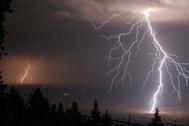- Lightning Protection Services /
- Industrial/Commercial Protection Systems

Industrial / Commercial Lightning Protection Systems
And Class II Buildings (Over 75’ Tall)
The same major groups of components are used to install lightning protection systems on industrial, commercial, and government facilities and structures as are used on residential systems.
However, since these types of buildings are more extensive and complex than residential, so too will be the lightning protection system. In addition, once the height of the building exceeds 75’ above grade, the required cables and components become significantly larger and heavier.

Air Terminals
As in residential systems, these components also known as “strike termination devices” are the top portion of the system where the initial contact takes place between the lightning discharge and the lightning protection system. In recent years, Thompson, and the industry in general, have switched in most cases to blunt (rounded tip) air terminals as opposed to the historically traditional sharp tip air terminals. This is based on research by the late Dr. Charles B. Moore at the University of New Mexico where it was found that blunt tip rods (up to 1” diameter) are better lightning receptors than very sharply pointed rods.


As mentioned earlier, there is a code dictated increase in air terminal size once a structure exceeds 75’ in height. Specifically, copper air terminals change from 3/8” minimum diameter for “Class I” (under 75’) system – vs- ½” minimum diameter for “Class II” (over 75’). Aluminum air terminals change from “Class I” ½” minimum diameter to “5/8” minimum diameter for Class II. There are a wide variety of air terminals and mounting bases available so suit all building configurations. If not, we will make them to suit.

Conductors
As in Class I applications, these specialty cables conduct the “lightning strike” safely from the air terminals to ground. Once the 75’ height is reached, as for air terminals, the sizes increase significantly for both copper and aluminum cables. In fact, they basically double in weight per 1000’ and circular mil area.

Either copper or aluminum conductors are acceptable for use dependent upon project conditions and specification preference.
Please note that there are very specific code criteria cited to prevent the combination of dissimilar metals. Copper and aluminum cannot be mounted on the opposite metal nor spliced unless special bimetal fittings are used. Also, copper cannot be mounted on galvanized or galvalume plated steel surfaces.

Finally, it must be noted that lightning protection system cables are of a special multi-strand construction and are not rated by normal AWG sizes. Refer to codes and catalogs for further information.

Bonding
bonding-equipmentFor Class II applications, these fittings and splicers used to make side flash preventing connections must be of heavy cast construction (either bronze, copper or aluminum) with bolt pressure connections. Hand crimp Class I fittings are not used for Class II systems. Very special & extensive bonding criteria come into play for buildings over 200’ tall.

Ground
Beyond the single driven rods described for Class I use, Industrial, Commercial and Class II building systems often employ much more elaborate and extensive grounding methods. These can include buried plates and cable grids in addition to, or in place of, the driven rods. Also, in some cases, chemical backfill or encapsulation products are used to reduce overall system resistance to ground.



Surge Arresters
As building height, size and service loads increase, the need arises for larger, more robust surge protection devices on all incoming services to shunt over-voltages on these lines safely to ground. The electrical designer must be involved and responsible for selecting and specifying the appropriate arrester for each building system.



Special Items
In addition to protection for adjacent trees, etc., Class II / Commercial Industrial buildings may also bring into the system such items as satellite dish antennas and special or oversize roof top mechanical equipment, handrails, platforms, etc.
View Lightning Protection Products



